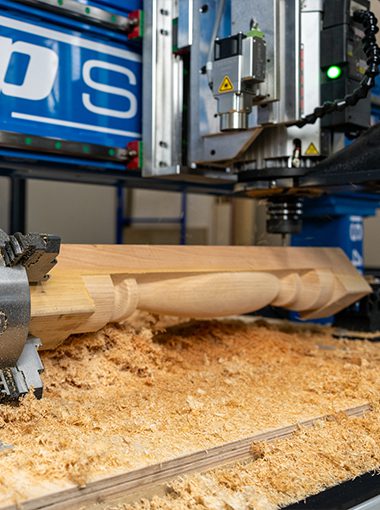Hardwood vs. Softwood in CNC woodworking
Every material has different properties and its own set of strengths and weaknesses, and what you’re using in the shop will play a key role in how you work with it and what you’re able to accomplish. Material has an impact on everything from tool choice and feed rate to cutting speed and beyond.
Working with wood is certainly no exception, and there are many different types to choose from to best complete a given project in the realms of furniture, cabinetry, signage, and more.
Here’s a closer look at how hardwoods and softwoods vary from one another, as well as a few popular examples of each to help launch your next CNC woodworking job.

Hardwood
Hardwood typically comes from deciduous trees (trees that shed their leaves in the fall) and is for the most part harder, darker, and more durable than softwood. They are great for cutting intricate details and for making smaller cuts, but make sure to check the RPM of your bit before you cut. If your RPM is too high, it can cause hardwood to start to burn right there on the router table.
Hardwood grows a bit more slowly than softwood, and because of this it can tend to be a bit more expensive, but it is still a long-lasting material great for crafting high-quality furniture, decks, flooring, and more. Here’s a look at several popular types of hardwoods and their key characteristics.
- Ash is heavy and light in color with lots of rings in its grain.
- Beech is strong, stiff, and shock-resistant, and its small pores mean it is less likely to splinter than a more porous alternative.
- Birch is a stiff wood with a very light color and a wavy grain.
- Cherry is a light reddish-brown hardwood that is strong and resistant to warping, making it a popular choice for carving.
- Elm is light brown in color and tough, though it does have a fairly low decay resistance.
- Mahogany is a strong reddish-brown wood with even pores and indistinct rings. It also works well for carving.
- Maple is one of the hardest woods out there and is useful for its durability. It also resists electrical shock well and has even pores and grain.
- Oak is heavy and hard and rarely breaks. Its ring grain is prominent, making it useful for beautiful visual applications.
- Walnut is a strong, durable brown hardwood with a straight grain in its trunk that grows wavier toward the roots.
View our collection of CNC routers and CNC plasmas at ShopSabre!
Softwood
Softwood is mostly derived from coniferous trees (trees that have needles that don’t shed in the winter) and is often lighter in color. Most timber comes from softwood. It is often easier to cut but if your bit is dull or of poor quality, splintering is likely to occur.
Some softwoods are harder than others, so be sure you are selecting the right kind for your project. Furniture, doors, windows, and paper products are some popular uses of softwoods. Here are some popular kinds that could serve you well on your next CNC project.
- Cedar is most noted for its distinct, pleasing aroma and its reddish-brown color. It can be somewhat challenging to work with due to its many knots, however.
- Cypress is also known for having knots and is not particularly strong, though it does have good decay resistance.
- Fir has an even consistent pattern and is fairly easy to work with.
- Pine has a lighter pale color, is lighter in weight, and is resistant to shrinking.
- Redwood is also noted for its red shade and is resistant to decay from sunlight.
- Spruce is one of the harder softwoods and is fairly lightweight, though it is not decay-resistant.
- Yew is harder than many hardwoods and is also easy to work with due to its straight grain. It resists decay well and has a medium strength and low stiffness.
Other types of wood
Medium-density fiberboard (MDF) is made of a mixture of hardwoods, softwoods, and wax and resin binders, and while it cuts smoothly and is easy to work with via CNC machines, it is many times recommended for projects that will be painted or otherwise hidden after being cut as it is not a very attractive material.
Plywood is created by layering sheets of material together with glue. Because of this, the direction of the grain changes from one layer to the next, making plywood more likely to chip or splinter. It is not recommended to produce high-level CNC work, but it can serve as a good material for practice cuts or economical processes.
Master your CNC woodworking with ShopSabre
ShopSabre’s industry-best CNC machines provide precision, efficiency, and total versatility to help aspiring hobbyists and full-time commercial shop owners alike produce truly outstanding results with a fraction of the labor. Shop our unmatched collection of CNC routers and plasmas today to take your shop’s quality and productivity to the next level.



